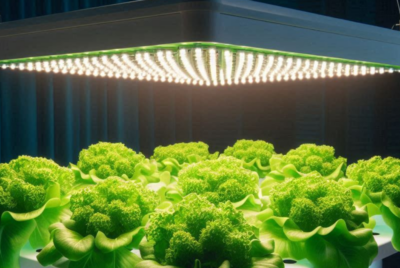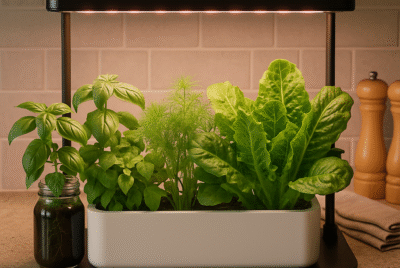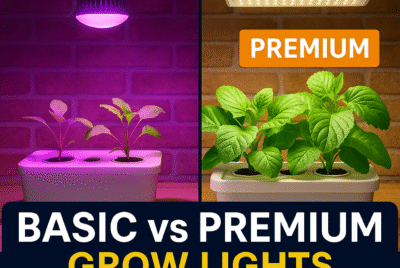Hydroponic Clay Pebbles: Success Guide
Hydroponic clay pebbles have earned a solid reputation in the world of soilless growing systems. Whether you’re new to hydroponics or a seasoned grower, knowing how to use them properly can significantly improve your yields. I’ve been using them for a while in my own hydroponic tower garden, and the results have been amazing. In this comprehensive guide, I’ll share my experiences, offer practical tips, review top products, and show you how to get the most out of hydroponic clay pebbles across various systems, from DWC hydroponics to ebb and flow hydroponics .
What Are Hydroponic Clay Pebbles?
Hydroponic clay pebbles, also known as expanded clay , are lightweight, porous balls that are heated to very high temperatures. These tiny spheres are perfect for hydroponic tower gardens because they retain moisture while providing excellent aeration to plant roots. The way they work is simple: the porous surface holds onto water and nutrients but allows excess water to drain, which prevents the roots from sitting in water and drowning.
Here are five key recommendations when considering using hydroponic clay pebbles in your hydroponic system:
1. Choose pebbles that are uniform in size . This ensures consistent water retention and aeration.
2. Avoid overfilling your grow beds or hydroponic towers. Clay pebbles expand when soaked, so give them room.
3. Look for high-quality clay pebbles like Hydrofarm Hydroton to ensure minimal dust and residue.
4. Ensure that the pebbles are pH neutral . This is crucial for proper nutrient uptake.
5. Clean and sterilize the pebbles after every growth cycle to extend their usability.
Top Hydroponic Clay Pebbles:
1. Hydrofarm GROW!T Clay Pebbles – These pebbles are a top choice for hydroponics enthusiasts. They’re lightweight, pH-stable, and offer excellent aeration and water retention. (Rating: ★★★★★)
2. Mother Earth Hydroton Original Clay Pebbles – Known for their high durability and ability to be reused, these are ideal for systems like DWC and ebb and flow hydroponics. (Rating: ★★★★☆)
3. Viagrow VCCB5 Clay Pebbles – This affordable option provides all the benefits of high-quality clay pebbles and comes in a large bag for bigger projects like hydroponic tower DIY setups. (Rating: ★★★★☆)
4. Hydro Crunch Expanded Clay Pebbles – Excellent for hydroponic systems that require heavy watering cycles, thanks to their ability to drain quickly while retaining moisture. (Rating: ★★★★☆)
5. PowerGrow Hydroponic Clay Pebbles – A reliable choice for various hydroponic systems, offers excellent aeration. (Rating: ★★★★☆)
Why Use Hydroponic Clay Pebbles?
If you’re wondering why hydroponic clay pebbles are so popular in systems like Kratky hydroponics and DWC hydroponics , the answer is simple: they strike the perfect balance between water retention and aeration. The pebbles allow the roots to breathe while still supplying them with enough moisture. This reduces the risk of root rot, which is a common issue in overwatered plants.
Key Benefits of Using Hydroponic Clay Pebbles:
1. Aeration : The pebbles’ porous structure promotes airflow, keeping roots oxygenated, which is crucial for healthy growth.
2. Water Retention : They retain moisture without becoming waterlogged, making them ideal for systems like ebb and flow hydroponics .
3. Reusability : After a quick rinse and sterilization, you can reuse them for multiple growing cycles, saving both money and the environment.
4. Stability : Pebbles provide excellent support for plants, especially in systems like hydroponic tower gardens where stability is critical.
5. pH Neutrality : Unlike other growing mediums, hydroponic clay pebbles don’t affect the pH of your nutrient solution, allowing for better control of hydroponics nutrients .
How Hydroponic Clay Pebbles Work in Hydroponic Systems
In hydroponic tower gardens and other setups, the key to success is ensuring the roots have a stable environment. Clay pebbles create a matrix that keeps roots elevated and supported, while allowing water and nutrients to flow freely. This is particularly important in aeroponics vs hydroponics , where airflow around the roots is essential.
How Hydroponic Clay Pebbles Function:
1. Support : In setups like DWC hydroponics , clay pebbles anchor the plant and provide a stable environment for root growth.
2. Water Flow : Pebbles allow water to pass through them, ensuring roots get adequate hydration without waterlogging.
3. Nutrient Absorption : The pebbles absorb nutrient-rich water and make it available to the roots.
4. Aeration : The porous surface allows oxygen to circulate freely around the roots, preventing suffocation.
5. Moisture Regulation : They maintain a balance by retaining some moisture while letting excess water drain away.
Types of Hydroponic Systems that Use Clay Pebbles
Hydroponic clay pebbles are highly versatile and can be used in a range of hydroponic systems. I’ve personally found them to work best in ebb and flow hydroponics and DWC hydroponics . However, they can also be used in more passive systems like Kratky hydroponics .
Top Systems That Work Well with Hydroponic Clay Pebbles:
1. Deep Water Culture (DWC) : The pebbles sit at the base of the plant, supporting it while allowing nutrient-rich water to flow through.
2. Ebb and Flow Systems : Here, the pebbles allow for water to flood the root zone and then drain, preventing over-saturation.
3. Drip Systems : The clay pebbles absorb dripped nutrients, ensuring a constant feed for the plants.
4. Kratky Hydroponics : In this passive system, pebbles provide both stability and nutrient retention without the need for pumps.
5. Hydroponic Tower DIY Systems : Pebbles are a great option for supporting plants in vertical setups due to their lightweight nature.
Best Practices for Using Hydroponic Clay Pebbles
When I started using hydroponic clay pebbles, I realized that there are a few best practices that can really make or break your success. Prepping them is essential, and there are a few other things you should keep in mind to get the most out of them.
Five Best Practices to Follow:
1. Always rinse the pebbles thoroughly before use. This removes dust and debris that could clog your system or affect your water quality.
2. Soak the pebbles in pH-neutral water for 24 hours before placing them into your system. This ensures they won’t alter the pH of your nutrient solution.
3. Use the right size of pebbles . Larger pebbles work well for bigger plants, while smaller ones are better for seedlings and young plants.
4. Monitor the moisture levels . Don’t let the pebbles dry out completely between watering sessions, as this can stress the plants.
5. Avoid overpacking the grow bed . The pebbles need some room to expand, and roots need space to grow, so don’t overcrowd them.
How to Reuse Hydroponic Clay Pebbles
One of the main reasons I love hydroponic clay pebbles is that they are reusable. After each growing cycle, I make sure to clean and sterilize them so I can use them again in my next crop. It’s an environmentally friendly and cost-effective option.
Five Steps to Reuse Hydroponic Clay Pebbles:
1. Remove any plant roots or debris by hand after harvesting.
2. Rinse the pebbles thoroughly to remove any leftover nutrients or salts.
3. Soak the pebbles in a mild bleach solution (1 part bleach to 9 parts water) for 24 hours to sterilize them.
4. Rinse the pebbles again to remove any bleach residue.
5. Let them dry completely before storing or reusing them for your next crop.
My Personal Experience with Hydroponic Clay Pebbles
When I first started with DWC hydroponics , I was skeptical about how well hydroponic clay pebbles would work compared to other growing mediums. But after trying them in several systems, including my hydroponic tower garden , I’m convinced they’re one of the best growing mediums available. They provide great root support, excellent moisture retention, and their reusability makes them a sustainable choice. Over time, I’ve seen fewer issues with root rot, better aeration, and overall healthier plants.
Tips for Getting the Best Results with Hydroponic Clay Pebbles
If you want to maximize your success with clay pebbles, follow these tips:
1. Rinse the pebbles regularly to prevent salt buildup from nutrient solutions.
2. Layer the pebbles in your system to ensure even moisture distribution.
3. Monitor your pH levels regularly. Although clay pe
bbles are pH neutral, other factors in your system may cause fluctuations. Keeping an eye on the pH ensures optimal nutrient uptake.
4. Mix pebbles with other media like perlite or coco coir for better moisture balance in systems that require different levels of water retention.
5. Use a root stimulator to encourage stronger root growth, especially if you’re working with young plants or seedlings.
How to Clean Hydroponic Clay Pebbles After Each Grow Cycle
To ensure the longevity of your hydroponic clay pebbles and maintain a healthy growing environment, cleaning them after each growth cycle is crucial. A buildup of salts, nutrient residues, and plant debris can affect the efficiency of your system and the health of your plants. Here’s how I clean my pebbles to keep them in perfect condition.
Five Steps for Cleaning Hydroponic Clay Pebbles:
1. Manual Debris Removal : After harvesting your plants, begin by removing as much plant matter and root debris as possible. You can do this by hand or using a sieve to shake the pebbles.
2. Initial Rinse : Place the pebbles in a large container and rinse them thoroughly with water to remove any loose dirt and nutrient residue.
3. Sterilization : Soak the pebbles in a 5% bleach solution or a hydrogen peroxide solution for at least 24 hours. This kills any bacteria, mold, or pathogens that may have accumulated during the growth cycle.
4. Final Rinse : Rinse the pebbles again with clean water to remove any traces of the cleaning solution. Ensure that they are completely free of chemicals before reusing them.
5. Dry and Store : Allow the pebbles to dry completely in the sun or indoors in a well-ventilated area. Store them in a clean, dry space until you’re ready to use them again.
Following these steps not only ensures that your pebbles are ready for the next crop but also helps maintain a healthy growing environment in your hydroponic tower garden or other systems.
Best Hydroponic Systems to Use with Hydroponic Clay Pebbles
Hydroponic clay pebbles are extremely versatile and work well in various hydroponic systems. If you’re new to hydroponics, you might be wondering which system is the best fit for clay pebbles. Based on my experience, here are the top five systems where clay pebbles shine:
1. Deep Water Culture (DWC Hydroponics) : This system allows the roots to grow into nutrient-rich water while being anchored by clay pebbles in a net pot. Clay pebbles are perfect for providing stability without suffocating the roots.
2. Ebb and Flow Hydroponics : In this system, the clay pebbles provide excellent drainage as water floods and drains through the root zone. The pebbles help to keep the roots moist without waterlogging.
3. Drip Irrigation Systems : Clay pebbles work well in drip systems because they allow the water to drain away from the roots quickly while still retaining some moisture for steady nutrient absorption.
4. Kratky Hydroponics : Since this passive system doesn’t rely on pumps, the moisture-retaining properties of clay pebbles help keep the roots hydrated for longer periods between waterings.
5. Hydroponic Tower DIY Systems : These systems are vertical by nature, and lightweight clay pebbles are ideal for providing stability without putting too much weight on the system.
Top Hydroponic System Recommendations:
1. VIVOSUN Hydroponics Growing System, 5-Gallon DWC Kit – Ideal for those starting with DWC hydroponics, compatible with clay pebbles. (Rating: ★★★★★)
2. Aerospring 27-Plant Vertical Hydroponic Tower – Perfect for small spaces, and the lightweight nature of clay pebbles makes it a great fit for this setup. (Rating: ★★★★☆)
3. General Hydroponics WaterFarm Complete Drip System – A great option for drip irrigation systems, especially with clay pebbles for optimal drainage. (Rating: ★★★★☆)
4. Active Aqua Ebb & Flow Hydroponic System – Ideal for ebb and flow systems, with clay pebbles offering excellent moisture control. (Rating: ★★★★★)
5. Hydrofarm Root Spa 8-Bucket System – A great DWC system that pairs well with clay pebbles for root stability. (Rating: ★★★★☆)
Hydroponics Nutrients and Their Role with Hydroponic Clay Pebbles
When using hydroponic clay pebbles , nutrient management is key. Since clay pebbles do not hold nutrients, it’s essential to provide a steady flow of nutrient-rich water to ensure your plants thrive. Whether you’re using Kratky hydroponics or DWC hydroponics , getting the nutrient balance right will determine your success.
Five Nutrient Tips for Hydroponic Clay Pebbles:
1. Use a complete nutrient solution . Ensure that it contains the right mix of nitrogen, phosphorus, and potassium, as well as micronutrients like calcium and magnesium.
2. Monitor pH levels frequently . The ideal pH range for most plants is between 5.5 and 6.5. Although clay pebbles are pH-neutral, nutrient solutions can fluctuate.
3. Check for nutrient deficiencies . Signs of yellowing leaves or stunted growth might indicate that your nutrient solution needs adjustment.
4. Flush the system regularly . This helps prevent nutrient buildup, which can affect the availability of nutrients to the plants.
5. Use hydroponic-specific nutrients . These solutions are designed for soilless systems like hydroponic tower gardens and provide everything your plants need.
Aeroponics vs Hydroponics: Where Do Clay Pebbles Fit In?
When comparing aeroponics vs hydroponics , you might wonder where hydroponic clay pebbles fit into the picture. While clay pebbles are a staple in most hydroponic systems, they are less common in aeroponics due to the nature of that system. In aeroponics, roots are suspended in the air and misted with nutrients, so there’s less need for a growing medium like clay pebbles.
That said, you could use clay pebbles in hybrid systems that incorporate both aeroponic and hydroponic elements. For example, using clay pebbles to stabilize plants in a net pot, while allowing their roots to grow down into the misting chamber.
Hydroponic Tower DIY: Building Your Own System with Clay Pebbles
If you’re a DIY enthusiast, creating a hydroponic tower is a fun and rewarding project. I’ve built several towers for my garden, and I always rely on hydroponic clay pebbles for support and moisture retention. Building your own tower gives you the flexibility to customize the height, number of plants, and type of nutrients you use.
Five Tips for Building a DIY Hydroponic Tower:
1. Choose durable materials . PVC pipes are often used for tower structures because they’re lightweight and easy to work with.
2. Use net pots . These allow for good drainage, and the clay pebbles will keep the plants stable.
3. Create a steady water flow . Use a pump to ensure nutrient-rich water is continuously cycling through the tower.
4. Keep it lightweight . Clay pebbles are perfect for DIY towers because they provide plant support without adding too much weight.
5. Monitor plant growth . Because towers are vertical, ensure that each plant gets equal access to light and nutrients.
Conclusion
In my years of experimenting with various hydroponic systems, hydroponic clay pebbles have remained one of my favorite growing mediums. Their ability to provide both aeration and water retention makes them an essential component for anyone serious about hydroponics. Whether you’re setting up a hydroponic tower garden , trying out ebb and flow hydroponics , or experimenting with Kratky hydroponics , clay pebbles are a versatile, sustainable, and effective choice.
FAQs
1. Can hydroponic clay pebbles be reused?
Yes! You can reuse them for multiple growing cycles. Simply clean and sterilize them between crops to ensure they remain free of pathogens and nutrient buildup.
2. How do hydroponic clay pebbles compare to other growing mediums?
Clay pebbles offer excellent aeration and water retention, unlike mediums like rockwool or perlite. They are also reusable, which makes them more eco-friendly and cost-effective in the long run.
3. Are hydroponic clay pebbles suitable for all hydroponic systems?
Almost all! They work particularly well in systems like DWC hydroponics , ebb and flow , and hydroponic tower gardens . They may not be necessary in aeroponic systems, where plants are misted instead of submerged.
4. How do I prevent salt buildup in clay pebbles?
Regularly flush your system with clean water, and rinse your pebbles between growth cycles to prevent salt accumulation.
5. Do hydroponic clay pebbles affect pH?
No, clay pebbles are pH-neutral, which means they won’t affect the pH of your nutrient solution. However, always monitor your solution to ensure that the pH levels remain stable, as nutrient solutions can fluctuate over time. Regular pH testing and adjustments are crucial for maintaining plant health.
Incorporating hydroponic clay pebbles into your hydroponic system is one of the best ways to improve plant health and growth efficiency. These small but mighty pebbles are an essential tool for any grower, whether you’re a beginner setting up your first hydroponic tower garden or an experienced grower experimenting with advanced techniques like Kratky hydroponics . Their versatility, sustainability, and reusability make them an indispensable part of modern hydroponics.
*We may earn a commission from purchases made through our links, at no cost to you. This does not affect our product recommendations. Please see our disclosure to learn more.




